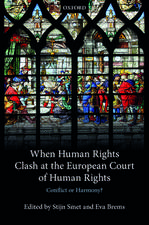Norms of Protection: Responsibility to Protect, Protection of Civilians and Their Interaction
Editat de Angus Francis, Vesselin Popovski, Charles Sampforden Limba Engleză Paperback – 20 noi 2012
A series of humanitarian tragedies in the 1990s (Somalia, Rwanda, Srebrenica, Kosovo) demonstrated the international community's failure to protect civilians in the context of complex emergencies. They were the inspiration for two norms of protection, Responsibility to Protect (R2P) and Protection of Civilians (POC), both deeply rooted in the empathy that human beings have for the suffering of innocent people. Both norms have achieved high-level endorsement: R2P from the 2005 World Summit and its Outcome document (Art. 138-140) and POC from a series of Security Council resolutions. The two norms of protection were instrumental in adopting the Security Council Resolutions 1970 and 1973 (Libya) and 1975 (Cote d'Ivoire) in the year 2011.
Both norms raise concerns of misinterpretation and misuse. They both are developing—sometimes in parallel, sometimes diverging, and sometimes converging—with varying degrees of institutionalization and acceptance. This process is likely to continue for some time, with successes and failures enhancing or retarding that development. This book engages in a profound comparative analysis of the two norms and aims to serve policymakers at different levels (national, regional, and UN), practitioners with protective roles (force commanders, military trainers, strategists, and humanitarian actors), academics and researchers (in international relations, law, political theory, and ethics), civil society, and R2P and POC advocates.
Both norms raise concerns of misinterpretation and misuse. They both are developing—sometimes in parallel, sometimes diverging, and sometimes converging—with varying degrees of institutionalization and acceptance. This process is likely to continue for some time, with successes and failures enhancing or retarding that development. This book engages in a profound comparative analysis of the two norms and aims to serve policymakers at different levels (national, regional, and UN), practitioners with protective roles (force commanders, military trainers, strategists, and humanitarian actors), academics and researchers (in international relations, law, political theory, and ethics), civil society, and R2P and POC advocates.
Preț: 315.32 lei
Nou
Puncte Express: 473
Preț estimativ în valută:
60.34€ • 63.13$ • 50.12£
60.34€ • 63.13$ • 50.12£
Carte tipărită la comandă
Livrare economică 03-17 aprilie
Preluare comenzi: 021 569.72.76
Specificații
ISBN-13: 9789280812183
ISBN-10: 9280812181
Pagini: 388
Dimensiuni: 152 x 229 x 20 mm
Greutate: 0.5 kg
Editura: Brookings Institution Press
Colecția United Nations University Press
ISBN-10: 9280812181
Pagini: 388
Dimensiuni: 152 x 229 x 20 mm
Greutate: 0.5 kg
Editura: Brookings Institution Press
Colecția United Nations University Press
Notă biografică
Angus Francis is senior lecturer and program leader, Human Rights and Governance Program, Faculty of Law, Queensland University of Technology. Vesselin Popovski is senior academic officer and head of the "Peace and Security" section, Institute for Sustainability and Peace at the United Nations University. Charles Sampford is foundation dean and professor of law and research professor in ethics, Griffith University, and director of the Institute for Ethics, Governance and Law.
Descriere
A series of humanitarian tragedies in the 1990s (Somalia, Rwanda, Srebrenica, Kosovo) demonstrated the international community's failure to protect civilians in the context of complex emergencies. They were the inspiration for two norms of protection, Responsibility to Protect (R2P) and Protection of Civilians (POC), both deeply rooted in the empathy that human beings have for the suffering of innocent people. Both norms have achieved high-level endorsement: R2P from the 2005 World Summit and its Outcome document (Art. 138-140) and POC from a series of Security Council resolutions. The two norms of protection were instrumental in adopting the Security Council Resolutions 1970 and 1973 (Libya) and 1975 (Cote d'Ivoire) in the year 2011.
Both norms raise concerns of misinterpretation and misuse. They both are developing—sometimes in parallel, sometimes diverging, and sometimes converging—with varying degrees of institutionalization and acceptance. This process is likely to continue for some time, with successes and failures enhancing or retarding that development. This book engages in a profound comparative analysis of the two norms and aims to serve policymakers at different levels (national, regional, and UN), practitioners with protective roles (force commanders, military trainers, strategists, and humanitarian actors), academics and researchers (in international relations, law, political theory, and ethics), civil society, and R2P and POC advocates.
Both norms raise concerns of misinterpretation and misuse. They both are developing—sometimes in parallel, sometimes diverging, and sometimes converging—with varying degrees of institutionalization and acceptance. This process is likely to continue for some time, with successes and failures enhancing or retarding that development. This book engages in a profound comparative analysis of the two norms and aims to serve policymakers at different levels (national, regional, and UN), practitioners with protective roles (force commanders, military trainers, strategists, and humanitarian actors), academics and researchers (in international relations, law, political theory, and ethics), civil society, and R2P and POC advocates.
















